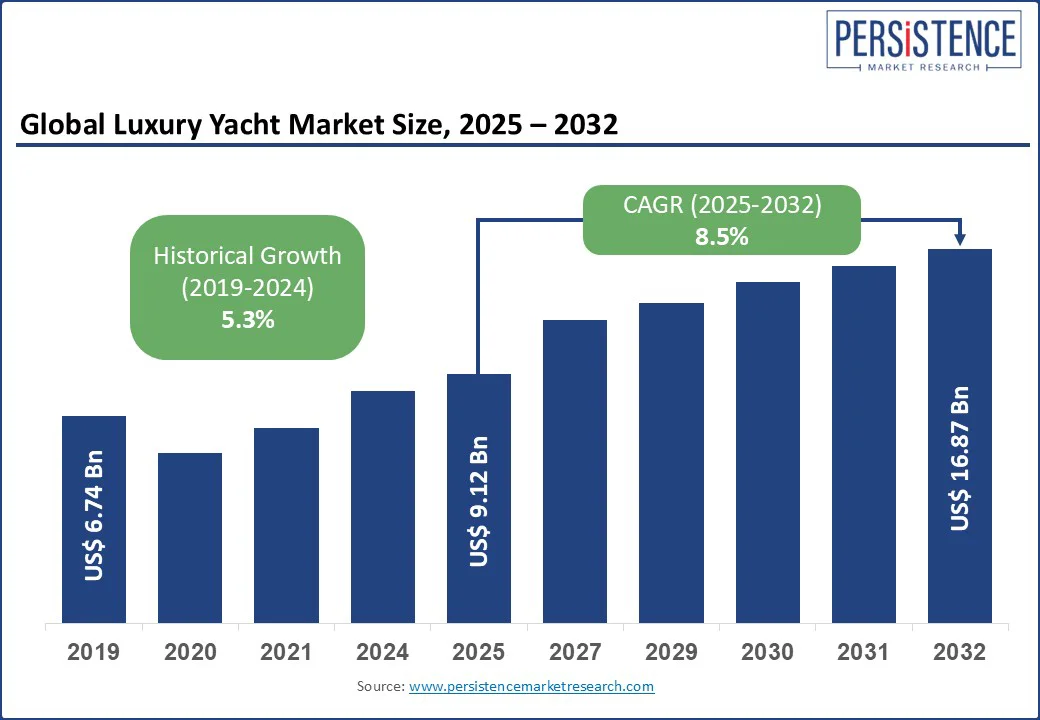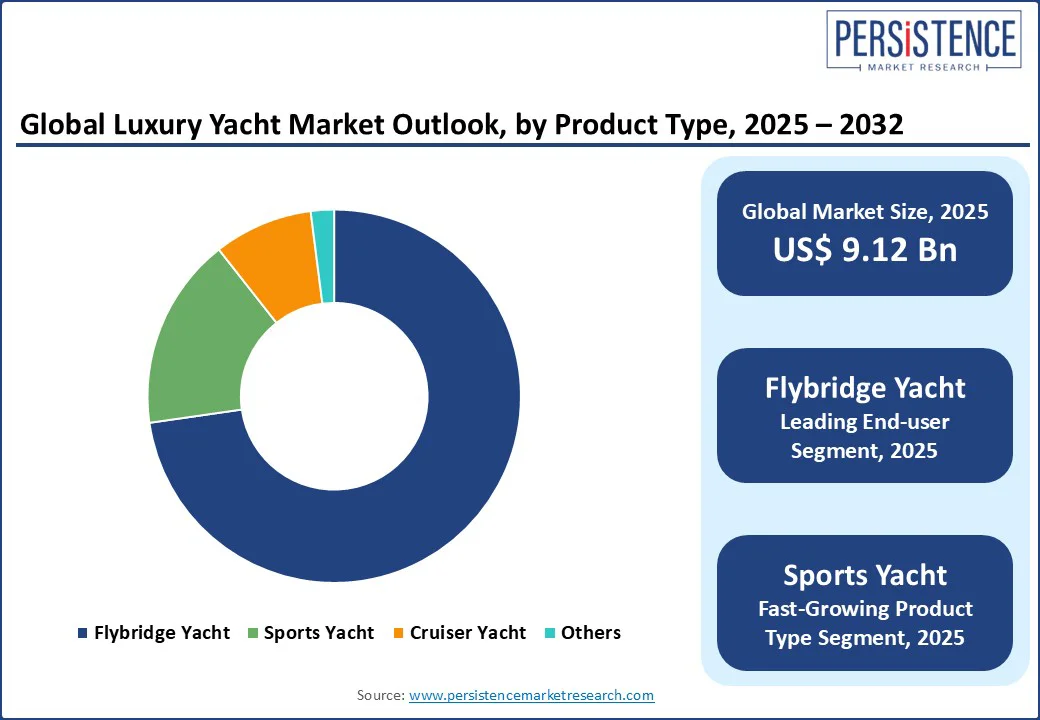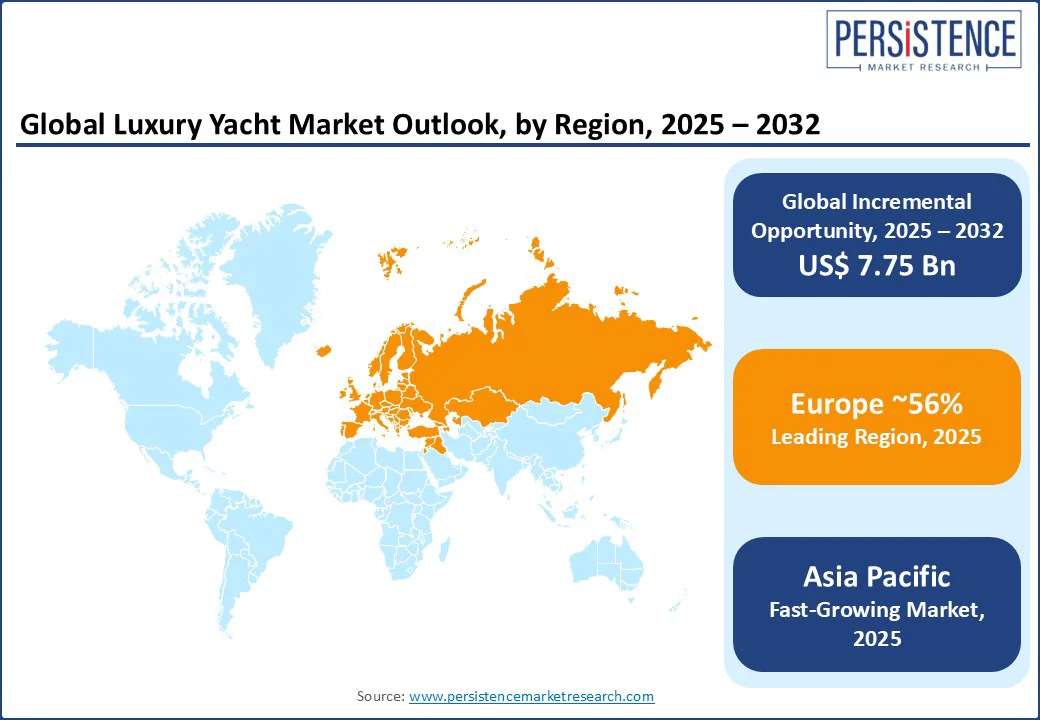ID: PMRREP35125| 197 Pages | 11 Aug 2025 | Format: PDF, Excel, PPT* | Consumer Goods

The Global Luxury Yacht Market size is likely to be valued at US$ 9.12 Bn in 2025 and is estimated to reach US$ 16.87 Bn in 2032, at a CAGR of 8.5% during the forecast period 2025 - 2032. The market growth is driven by the rising number of high-net-worth individuals (HNWIs), rise in recreational spending, growth in yacht charters, technological advancements, and expanding maritime tourism. Luxury yachts are private, high-end vessels that offer elite and highly exclusive travel experiences. They combine sophistication, comfort, advanced technologies, and innovative amenities, thereby ensuring safety, entertainment, and relaxation. These yachts offer personalized itineraries that offer access to some of the world’s most exotic destinations, blending adventure with elegance.

Key Industry Highlights
|
Global Market Attribute |
Key Insights |
|
Luxury Yacht Market Size (2025E) |
US$ 9.12 Bn |
|
Market Value Forecast (2032F) |
US$ 16.87 Bn |
|
Projected Growth (CAGR 2025 to 2032) |
8.5% |
|
Historical Market Growth (CAGR 2019 to 2024) |
5.3% |
Increasing wealth and disposable income among HNWIs is a key driver of market growth. The Wealth-X World Ultra Wealth Report 2024 highlights that UHNWIs (with US$ 30 mn+ in assets) saw a 9% increase in wealth in 2023, leading to higher disposable incomes and spending power. North America, particularly the U.S., led this growth. UHNWIs possess greater discretionary income, enabling higher spending on luxury goods and exclusive experiences such as private yachting. There is a high demand for technologically superior and bespoke yachts.
The market benefits directly from this wealth concentration as yachts are status symbols. The growing appetite for customized travel plans, on-board luxury amenities, and privacy on water highlights the shifting preferences of these affluent consumers. According to Continental Magazine’s May 2025 analysis, in 2025, an estimated 5-7% of HNWIs and 10-15% of UHNWIs own luxury yachts. North America and Europe lead, while Asia and the Middle East grow rapidly. Despite high costs, strategic ownership through chartering or fractional models makes yachts affordable. For HNWIs, yachts reflect status and economic growth, reinforcing their place in super-rich portfolios. Jeff Bezos, Larry Ellison, and Bernard Arnault own some of the world’s most luxurious yachts.
Luxury yachts contribute considerably to underwater noise pollution, posing serious risks to marine mammals such as whales, dolphins, and seals. This disruption makes them highly susceptible to anthropogenic noise. The underwater noise disturbs their ability to communicate, raises stress levels, causes temporary or permanent hearing loss, and alters feeding and migration behaviors. Superyacht noise caused by propellers accounts for up to 85% of underwater noise when underway. Chronic exposure, especially in areas including the Atlantic and Caribbean, can lead to long-term health effects and dislodgment from vital habitats.
Engines and onboard generators also emit continuous low-frequency sounds, which reverberate and amplify. Even when anchored, superyachts often operate their generators to support luxury amenities, contributing to 24/7 acoustic pollution. Marine noise pollution is now considered a major threat to ocean health, second only to climate change and chemical pollution. Seagrass damage from anchoring, antifouling paints, and the spread of invasive species are the other negative impacts of yachts. Moderate concerns involve greywater discharge, air emissions, and fuel or oil leaks, while lower-risk issues include sediment resuspension, blackwater discharge, light pollution, marine litter, and wildlife feeding. These cumulative impacts threaten biodiversity, especially in ecologically sensitive zones.
The luxury yacht industry is adopting sustainable design and innovative technologies. Tools such as the Superyacht Eco Association (SEA) Index and Yacht Environmental Transparency Index (YETI) are employed to reduce the carbon footprint. Biofuels, especially advanced synthetic diesels, are becoming popular due to their lower emissions. Companies such as Sunreef Yachts Eco have adopted electric propulsion, hybrid systems, wind & solar power, and hydro generation. AI-driven yacht designs optimize hull efficiency, fuel use, and onboard automation. Leading builders such as Lürssen, Feadship, Oceanco, and Heesen pioneer these innovations. Catamarans incorporate gyro stabilizers, smart climate control, and efficient hull designs to maximize comfort and fuel economy.
Connectivity innovations such as VSAT and Starlink bring high-speed internet to yachts worldwide, enabling real-time navigation, remote diagnostics, and telemedicine. Blockchain streamlines secure transactions and asset management, while 3D printing enables light yacht construction. Navigation tech now includes AI autopilots, augmented reality, and predictive analytics for optimal routing. Luxury yachts such as Oceanco ESQUEL and Sinot’s AQUA incorporate these features. Advanced materials such as shape memory alloys, self-healing coatings, and electrochromic glass are improving performance, durability, and comfort. AI optimizes navigation, predicts maintenance needs, and automates onboard systems, making superyachts efficient and safer.
By product type, the flybridge yacht segment is expected to dominate the market with approximately 72% market share during the forecast period. This yacht has an additional elevated deck above the main deck called the flybridge, which serves as an open-air helm station with 360-degree views for navigation and leisure. Larger flybridge yachts (over 24 meters) have two helm stations, one on the flybridge and one inside. Smaller models typically have only the flybridge helm. This facility offers enhanced visibility for safer navigation, especially in challenging waters, and also serves as a social space with seating, dining areas, sun loungers, wet bars, grills, and Jacuzzis, offering outdoor living and entertainment. Leading builders of flybridge yachts include Sunseeker, Princess Yachts, Ferretti Yachts, and Azimut. Modern flybridge superyachts, such as the Sunseeker 100 Yacht with its walk-around flybridge, merge practicality with luxury.
The sports yacht segment is likely to be the fastest-growing segment over the forecast period. A sports yacht is built for speed, agility, and adventure on the open water. Sports yachts focus on dynamic performance, boasting powerful engines, streamlined hulls, and features tailored for activities such as water sports and sport fishing. They are ideal for adventure seekers looking for some action in the sea. These yachts are sleek and contemporary with spacious saloons, cabins, and staterooms. Innovations such as hardtops and increased hull sizes are making sports yachts similar to flybridge yachts. As yacht designs are evolving, the distinctions between sports and flybridge yachts are blurring, offering buyers more versatile options without compromising on style or performance.
By application, the personal use segment is expected to dominate the market in 2025, accounting for around 70% of the market share. Personal yachts are privately owned vessels for personal leisure, recreation, and private use by the owner and their guests. The major drivers of this segment are the surge in UHNWIs, evolving lifestyle preferences, and major technological advancements. They typically do not carry passengers for a price and have limited regulatory constraints. AI automation, hybrid propulsion, and sustainable design have made yachts more appealing and efficient. VR tools and concierge services make the purchase and management process simpler. Feadship M/Y Symphony (owned by Bernard Arnault, the chairman and CEO of LVMH Moët Hennessy Louis Vuitton) and Lürssen M/Y Azzam are privately owned luxury superyachts.
The commercial use segment is projected to be the fastest-growing in the luxury yacht market. Commercial yachts are operated for chartering or offering paid services. They must also comply with stricter safety, crew certification, and operational regulations, such as international safety (SOLAS), pollution prevention (MARPOL), and crew certification (STCW) regulations, alongside flag state and classification society requirements. Commercial yachts are usually subject to inspections and licensing by maritime authorities. Examples of commercial yachts include charter yachts such as the 75m M/Y Eclipse available for private rentals, the 50m M/Y Kismet frequently used for luxury charters, and expedition yachts such as the 42m National Geographic Endurance. Charter firms, including Burgess Yachts, Fraser Yachts, Camper & Nicholsons, Northrop & Johnson, and Y.CO, manage fleets of commercial luxury charter yachts.

Europe is likely to dominate the market, accounting for over 56% of market share over the forecast period, driven by major yacht-building hubs in Italy, Germany, and the Netherlands, as well as a strong base of affluent buyers and well-established marine infrastructure. The presence of affluent buyers and the demand for highly customized yachts focused on sustainability are driving market growth. This growth is supported by stringent European Union environmental regulations and mandatory compliance with international maritime safety standards, pushing manufacturers toward greener vessels. the Netherlands’ Heesen Yachts is renowned for its innovative custom superyachts. Italy’s Sanlorenzo and Benetti are known for craftsmanship and quality.
Germany is witnessing significant growth within Europe. Germany has a robust maritime industry. German manufacturers are leading in eco-friendly yacht technology. Tyde and BMW collaborated on the largest foiling motor yacht on Earth that achieves an 80% reduction in energy consumption compared to traditional yachts. Germany houses Yachtbau, one of Europe's largest yacht manufacturers.
North America is likely to experience significant growth over the forecast period. Key drivers include an increasing number of HNWIs opting for yacht tourism, which combines leisure with scenic exploration. Smart automation, connectivity, and advanced safety features are enhancing the luxury yachting experience, along with increased adoption of sustainability initiatives incorporating solar panels, energy-efficient propulsion, and sustainable materials. Regulatory hurdles such as tariffs on foreign-built yachts and stricter crew documentation requirements can increase costs. Steep tariffs on foreign-built yachts and increased paperwork are forcing many buyers to cancel or delay orders, purchase pre-owned vessels, which may hamper the market in future.
The U.S. luxury yacht market is booming, supported by rising disposable incomes, a growing base of HNWIs, and a high demand for yacht tourism. There is an increased purchase of vessels—particularly those in the 75-250-foot range, made of FRP/composites and metal/alloys. Regional hotspots such as Florida, the Northeast, the Great Lakes, and the West Coast witness an increasing need for sustainable and tech-enhanced yachts. The industry also confronts challenges, including high costs, environmental compliance, tariffs, and crew regulations.
Asia Pacific is estimated to witness rapid growth over the forecast period, driven by rising numbers of UHNWIs, expanding marine tourism, and supportive government policies. China leads in ownership and infrastructure, but India is the fastest-growing market due to increasing wealth and relaxed regulations. Major users include UHNWIs and charter operators, with growing interest in eco-friendly yachts. Regulations are evolving across the region to support yacht-friendly policies, marina development, and sustainable technologies. Jackie Chan, Louis Koo, Mukesh Ambani, Lakshmi Mittal, and the Sultan of Oman own superyachts.
China's luxury yacht market is experiencing significant growth, fueled by rising wealth among UHNWIs, a growing leisure culture, and strong government support through marina and yacht club developments in cities including Shanghai and Sanya. Buyers favor customized super and sport yachts, influenced by social media trends. Yacht ownership is governed by a Chinese maritime code that necessitates compliance with national standards. Foreign companies may face challenges from cultural differences, requiring tailored services such as Mandarin-speaking staff and entertainment features. The market offers strong opportunities for players who adapt to China’s unique demands.

The global luxury yacht market is highly competitive, with global and domestic players offering a wide range of products and competing for a higher market share. Companies are investing in R&D and adopting growth strategies such as product innovations, strategic partnerships, and acquisitions.
The global market is projected to be valued at US$ 9.12 bn in 2025.
Market growth is driven by the rising number of high-net-worth individuals, rise in recreational spending, growth in yacht charters, technological advancements, and expanding maritime tourism.
The market is poised to witness a CAGR of 8.5% from 2025 to 2032.
The superyacht industry is adopting sustainable design and innovative technologies.
Major players in the Global Luxury Yacht Market include Azimut Benetti S.p.A., Sanlorenzo S.p.A, Ferretti Group, Feadship, and Princess Yachts.
|
Report Attribute |
Details |
|
Historical Data/Actuals |
2019 - 2024 |
|
Forecast Period |
2025 - 2032 |
|
Market Analysis |
Value: US$ Bn |
|
Geographical Coverage |
|
|
Segmental Coverage |
|
|
Competitive Analysis |
|
|
Report Highlights |
|
|
Customization and Pricing |
Available upon request |
By Product Type
By Size
By Application
By Region
Delivery Timelines
For more information on this report and its delivery timelines please get in touch with our sales team.
About Author